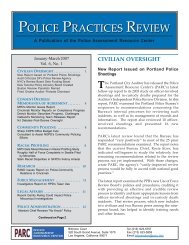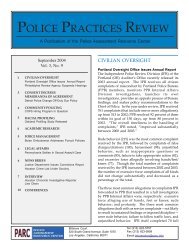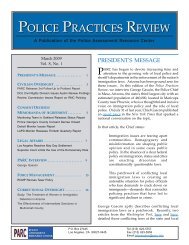July - Police Assessment Resource Center
July - Police Assessment Resource Center
July - Police Assessment Resource Center
Create successful ePaper yourself
Turn your PDF publications into a flip-book with our unique Google optimized e-Paper software.
VOL. 2, Issue 7 <strong>July</strong> 2003<br />
must transfer to a providing mental<br />
health service or “triage facility.” Many<br />
facilities require law enforcement<br />
officers to wait up to eight hours (if not<br />
longer) for the completion of a mental<br />
health evaluation.<br />
In many communities law enforcement<br />
officers have very limited or nonexistent<br />
community mental health services at<br />
their disposal. Law enforcement officers<br />
often choose the easy process of the<br />
criminal justice system (county jails),<br />
out of frustration in order to expedite<br />
what the public demands - police<br />
officers available and ready to respond<br />
to community law enforcement calls.<br />
PARC: Can you describe what steps the<br />
CIT typically takes upon being notified<br />
of a situation where they are needed?<br />
SC: A call will come through our 911<br />
system. A trained dispatcher listens and<br />
takes down information, noting anything<br />
that might indicate the existence of<br />
mental illness. The dispatcher also asks<br />
pointed questions in order to detect if it<br />
is a mental illness crisis call. If the call<br />
event is classified as such, the dispatcher<br />
will utilize a computer to locate the<br />
nearest available CIT officer.<br />
CIT officers are deployed throughout<br />
precincts – they perform other patrol<br />
police duties, but during a call event<br />
where mental illness issues are present<br />
the CIT officer can be dispatched<br />
anywhere within the city. Appropriate<br />
staffing allows for most CIT officers to<br />
remain within the geographical bounds<br />
of their assigned precinct.<br />
Once a CIT officer is assigned to a call<br />
event the dispatcher will then assign<br />
other officers to the same incident. In<br />
most events, all of the dispatched<br />
officers will meet and travel together to<br />
the event location. Our policy directs the<br />
lead CIT officer to oversee the crisis.<br />
Once on the scene, CIT officers will help<br />
stabilize the crisis and assist with any<br />
negotiations. In some instances the<br />
officer will appropriately refer<br />
community resources, and/or will<br />
transport the individual for an<br />
emergency commitment evaluation.<br />
PARC: What characteristics<br />
differentiate the CIT program from other<br />
law enforcement models that address<br />
mental illness?<br />
SC: Some agencies have a professional<br />
mental health person or a mobile mental<br />
health crisis team available for crisis<br />
calls. However, crisis response times or<br />
multiple crisis events occurring closely<br />
together can jeopardize the overall intent<br />
of a specialized crisis response plan.<br />
Sometimes things happen very rapidly<br />
and a delay in deployment can be<br />
extremely disadvantageous. Some<br />
communities have mental health and law<br />
enforcement officers riding together, and<br />
others will have CIT and mobile crisis<br />
teams working in unison – separate, but<br />
cooperating. Ultimately, each<br />
community should perform a needsassessment<br />
within the context of their<br />
community’s issues and circumstances.<br />
An honest assessment of existing<br />
services and operating systems should be<br />
one of the first priorities.<br />
PARC: What are the training<br />
requirements and standards for CIT<br />
officers and how do they differ from<br />
basic officer training?<br />
SC: The CIT training model begins with<br />
<strong>Police</strong> <strong>Assessment</strong> <strong>Resource</strong> <strong>Center</strong> 213-623-5757 www.parc.info 10
















